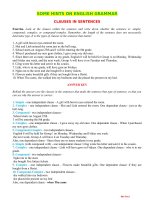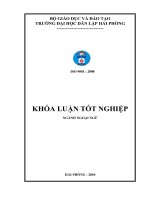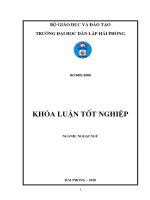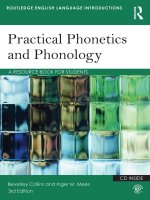Some definitions on English Phonetics and Phonology
Bạn đang xem bản rút gọn của tài liệu. Xem và tải ngay bản đầy đủ của tài liệu tại đây (45.67 KB, 6 trang )
Some definitions on English Phonetics and Phonology
1. WHAT IS A PHONEME?
- Both phonetics and phonology study and describe the distinctive sound units or phonemes
of a language and their relationship to one another.
- A phoneme is the smallest unit of sound in a language which can distinguish two words.
Ex: PAN and BAN differ only in their initial sound: /p/ and /b/ are phonemes.
- English has 44 phonemes which are classified into 24 consonants, 12 vowels and 8
diphthongs.
2. THE SPEECH ORGANS
The speech organs are the parts of the body that are used to produce the sounds. The speech
organs consist of:
- Articulators: The movable parts to modify the air stream to produce different sounds. The
articulators are:
1. Vocal cords in the larynx: Where sounds may be produced with vibration (voiced
sounds) or without vibration (voiceless sounds). The opening between the vocal cords is
called the glottis.
2. Pharynx: The tube above the larynx. The epiglottis in the pharynx can he raised or
lowered to open or close the way to the windpipe.
3. Tongue: The most important articulator because it is flexible and it can move to different
places in the mouth.
4. Uvula: The extreme back of the roof of the mouth. It can he raised or lowered to open or
close the passage to the nose.
5. Lower teeth (lower jaw): Behind the lower lip.
6. Lower lip: Faces the upper lip. It is flexible and can be pressed against the upper lip or
can be rounded or spread.
- Points of articulation: The fixed parts on the roof of the mouth towards which the
articulators move to produce sounds. Points of articulation are:
7. Upper lip: Opposite the lower lip.
8. Upper teeth (upper jaw): Opposite the lower teeth.
9. Alveolar ridge/ tooth ridge/ gum: Is between the upper teeth and the hard palate.
10. Hard palate/ roof of the mouth: The hard part of roof of the mouth.
11. Soft palate/ velum: The soft part of the roof of the mouth.
3. CONSONANTS AND THEIR CLASSIFICATION
1
I. What is a consonant?
- A consonant is a sound in producing it the airstream coming from the lungs is stopped,
impeded, constricted or otherwise interfered with in its passage to the outside air.
- Consonants are classed as VOICED if they are produced with vibration of the vocal cords
and VOICELESS if they are produced without vibration.
II. Classification of consonants: Consonants are classified according to these 4 standards:
A/ PLACES OF ARTICULATION:
1. Bilabial: 2 lips are pressed together. Ex: /p, b, m, w/
2. Labio-dental: The upper teeth and the lower lip come close together. Ex: /f, v/
3. Dental or Interdental: The tip of the tongue is between the upper and lower teeth. Ex: /
θ, ð /
4. Alveolar: The tip of the tongue touches the alveolar ridge. Ex: /t, d, 1, n, s, z/
5. Palato-alveolar: The front of the tongue touches the part between the alveolar ridge
and the hard palate. Ex: /r, tʃ, dʒ, ʃ, ʒ/
6. Velar: The back of the tongue touches the soft palate or velum. Ex: /k, g, ŋ/
7. Palatal: The front of the tongue touches the hard palate. Ex: /j/
8. Glottal: The sound is produced with a friction noise in the glottis between the vocal
cords. The glottis opens wide and the sound is voiceless. Ex: /h/
B/ MANNER OF ARTICULATION: The ways the airstream modifies the organs of
speech.
1. Plosive or stop: The air is stopped, then released with an explosive sound.
Ex: /p, b, t, d, k, g/
2. Fricative: The air is constricted, causing friction when passing through the organs of
speech. Ex: / f, v, θ, ð, s, z, ʃ, ʒ , h/
3. Affricate: It is the combination of the plosive and fricative. The air stream is stopped,
then released slowly with friction. Ex: /tʃ, dʒ/
4. Nasal: The air passes through the nose when the uvula is lowered. Ex: /m, n, ŋ/
5. Lateral: The air passes out at both sides of the tongue. Eg: /l/
6. Gliding or semi-vowel (consonant) or approximant: There is a gliding from one to
another with little or no obstruction of the air stream. The tip of the tongue approaches
alveolar ridge. Ex: /w, r, j/
C/ VOICING: There is presence or absence of the vibration of the vocal cords
1. Voiced: When the vocal cords open and close rapidly.
2
2. Voiceless: When the vocal cords open wide and there is the vibration of the vocal
cords.
D/ ASPIRATION
1. Aspirated: A sound is aspirated when it is at the beginning of a word or in a stressed
syllable. Ex: paper , pen , people
2. Unaspirated: A sound is unaspirated when it is before an unstressed syllable, before
another stop sound or after /s-/. Ex: paper , spy
SYLLABIC CONSONANTS
* Syllabic consonants are the ones which can form syllable without vowels. The small
vertical mark is used to show that a consonant is syllabic.
Ex: table /teibl/
4. VOWELS, TIIEIR CIASSIFICATION
I. VOWELS VS CONSONANTS
1) What is a vowel?
A vowel is a speech sound in which the airstream from the lungs is not blocked in any way
in the mouth or throat and which is usually pronounced with vibration of the vocal cords.
2) The difference between a vowel and a consonant:
They are different in 2 aspects:
a. A vowel is produced without any stoppage of the airstream in the oral cavity meanwhile
there is obstruction in the production of a consonant.
b. A vowel is syllabic, i.e. , it forms the centre or nucleus of a syllable meanwhile a
consonant is not except some syllabic consonants.
Ex: are (V) , car (CV) , art (VC) , cart (CVC).
II. CHARACTERISTICS TO CLASSIFY VOWELS
Vowels are classified according to these 5 standards:
1) TONGUE HEIGHT
- Tongue height is the vertical distance between the upper surface of the tongue and the
palate (= degree of opening of the mouth).
- The tongue may be raised high, mid or low.
- Correspondingly the position of the jaw may also be close, mid or open.
2) TONGUE POSITION:
This means the front, central or back of the tongue is raised or lowered.
3) LIP ROUNDING:
Different shapes and positions of the lips. They may be rounded, unrounded or neutral.
3
4) MUSCLE TENSION:
Tenseness in the muscles of the jaw and throat. The muscles may be lax or tense. Short
vowels are often lax vowels meanwhile tense vowels are often long vowels.
5) VOWEL LENGTH:
There are 5 long vowels: /i:, u:, Ɔ:, ə: a:/ and 7 short vowels: /i, u, Ɔ, ə, e, æ, ⋀/
5. THE ENGLISH DIPHTHONGS
I/ Definition
They are sounds consisting of a movement or glide from one vowel to another. In terms of
length, diphthongs are like long vowels.
II. Classification
1. Centering diphthongs: /iə/, /eə/, /uə/
2. Fronting diphthongs: /ei/, /ai/, /Ɔi/
3. Retracing diphthongs: /əu/, /au/
6. PHONEMES AND ALLOPHONES
I/ What is a phoneme?
- A phoneme is the smallest unit of sound in a language which can distinguish 2 words.
- For example:
a/ In English, the words PAN and BAN differ only in their initial sound: PAN begins with
/p/ and BAN with /b/.
b/ BEN and BIN differ only in their vowels: /e/ and /i/
Therefore / p b e i / are phonemes of English. The number of phonemes varies from one
language to another. English is often considered to have 44 phonemes: 24 consonants and
20 vowels.
II/ What is an allophone?
- An allophone is any of the different forms of a phoneme.
- For example: In English, when the phoneme /p/ occurs at the beginning of words like PUT
/put/ and PEN /pen/ , it is said with a little puff of air. That is, it is aspirated.
But when /p/ occurs in words like SPEND /spend/ and SPELL /spel/ it is unaspirated.
Both the aspirated in PEN and the unaspirated in SPELL have the same phoneme function.
That is, they are both heard and identified as [p] and not as [b]. They are both
ALLOPHONES of the PHONEME [p].
III/ The difference between a phoneme and an allophone
4
- A PHONEME is a meaning-distinguish sound in a language. If we substitute one sound
for another in a word and there is a change of meaning, then the 2 sounds represent different
phonemes.
Ex: TIE and DIE. They are not allophones.
- Otherwise if we substitute allophones, we have different pronunciation of the same word.
Ex: Phoneme [t] has got 2 allophones:
[tø] aspirated as in TAPE.
[t] unaspirated as in LETTER.
- Phonemes are transcribed phonemically in slant bars / / and allophones are transcribed
phonetically in square bracket [ ].
- As a result of this, we have 2 kinds of transcription: narrow transcription (phonetic
transcription) and broad transcription (phonemic transcription)
7. BROAD TRANSCRIPTION & NARROW TRANSCRIPTION
I/ Two types of transcription
A. Narrow transcription (also called phonetic transcription): The transcription in which
phonemes are transcribed phonetically (with allophones). The phonetic symbol is [ ] (square
brackets). This type is more complex, more detailed & gives more information about a
phoneme.
As a result, it is the study object of PHONOLOGY (PHONEMICS)
B. Broad transcription (also called phonemic transcription): The transcription in which
phonemes are transcribed phonemically. The symbol is / / (slant bars). This type is easy and
quick to learn. It is preferred due to these 2 reasons: simple phonemic symbols and easy
printing. As a result, it is the study object of PHONETICS
Ex : take / teik /
8. VARIATION
I/ Assimilation
- Assimilation is the influence of one phoneme upon another neighbouring phoneme, so that
they become more alike.
- Assimilation is more likely to be found in rapid, casual speech and less likely in slow,
careful speech.
- Assimilation affects consonant only.
II/ Elision
- Elision is the complete disappearance of a sound.
5
- Elision is typical of rapid casual speech. Foreign learners do not need to learn to produce
elisions, but the perception of elision is important.
III/ Linking
- Linking happens when we link words together, usually for ease of pronunciation.
Ex: Thousands of people. He eats and drinks.
/z əv/
/s ən/
Learners of English must be made aware of the problems that they will meet in listening to
colloquial, connected speech.
9. WORD/ PHRASE AND SENTENCE STRESS
- Stress is the degree of force used in producing a syllable.
- There are three types of stress in English: word, phrase and sentence stress.
- There are four degrees of stress: primary, secondary, tertiary and weak stress.
- All words of more than one syllable are stressed.
- The general rule of phrase and sentence stress:
CONTENT WORDS (nouns, demonstratives, adjectives, adverbs, verbs) often
receive the MAJOR STRESS meanwhile FUNCTION WORDS (prepositions, auxiliaries,
conjunctions and pronouns) usually carry the MINOR STRESS.
The primary stress is put on the most important word in a phrase or sentence. And
there is only one primary stress in each phrase or sentence.
10. STRONG & WEAK FORMS
- The strong form of a word is used when it is stressed or when it is at the end of a sentence
or when it is said in isolation.
- The weak form of a word is used when it is unstressed and not final.
- The content words like nouns, adjectives, verbs, adverbs have no weak forms. Only the
function words like auxiliary verbs, pronouns, prepositions, conjunctions may have the
weak forms.
11. THE ENGLISH RHYTHM
- Rhythm may be defined as regular succession of stressed syllables and unstressed ones.
- Rhythm often coincides with secondary and primary stress.
6









